ASRock Z97 OC Formula Motherboard Review: Less Lamborghini, More Yellow
by Ian Cutress on October 2, 2014 10:00 AM EST- Posted in
- Motherboards
- ASRock
- Overclocking
- Z97
System Benchmarks
Power Consumption
Power consumption was tested on the system while in a single MSI GTX 770 Lightning GPU configuration with a wall meter connected to the OCZ 1250W power supply. This power supply is Gold rated, and as I am in the UK on a 230-240 V supply, leads to ~75% efficiency > 50W, and 90%+ efficiency at 250W, suitable for both idle and multi-GPU loading. This method of power reading allows us to compare the power management of the UEFI and the board to supply components with power under load, and includes typical PSU losses due to efficiency. These are the real world values that consumers may expect from a typical system (minus the monitor) using this motherboard.
While this method for power measurement may not be ideal, and you feel these numbers are not representative due to the high wattage power supply being used (we use the same PSU to remain consistent over a series of reviews, and the fact that some boards on our test bed get tested with three or four high powered GPUs), the important point to take away is the relationship between the numbers. These boards are all under the same conditions, and thus the differences between them should be easy to spot.
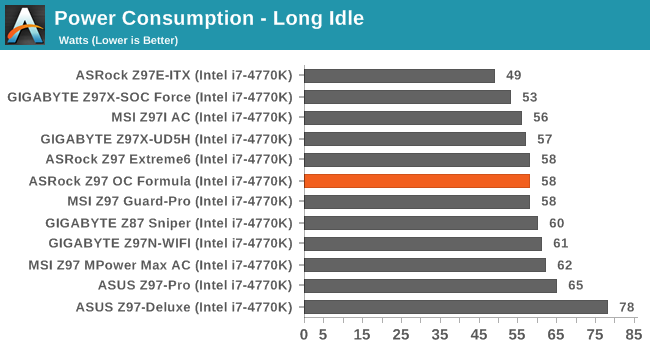
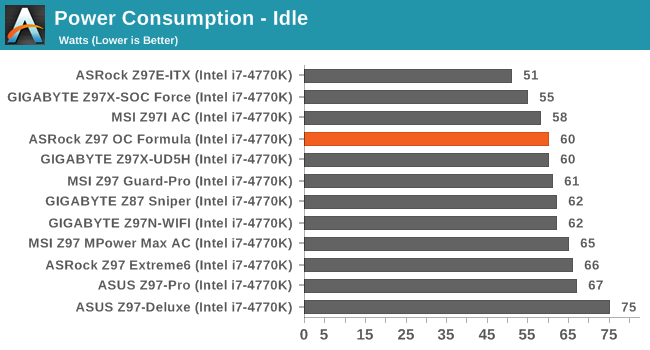
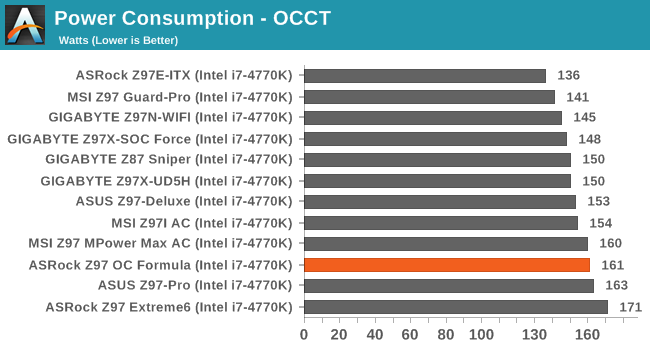
Idle and long idle power consumption is in the middle of the pack, although peak power consumption while under CPU load matches some of the higher power users.
Windows 7 POST Time
Different motherboards have different POST sequences before an operating system is initialized. A lot of this is dependent on the board itself, and POST boot time is determined by the controllers on board (and the sequence of how those extras are organized). As part of our testing, we look at the POST Boot Time using a stopwatch. This is the time from pressing the ON button on the computer to when Windows 7 starts loading. (We discount Windows loading as it is highly variable given Windows specific features.)

15 seconds is relatively slow for a POST time, although when stripped we get closer to 11 seconds indicating that the ASMedia controllers are doing some damage. One thing we have not looked at before is how ASMedia and other controllers compare to each other for POST time – I imagine there might be a cost element involved as well.
Rightmark Audio Analyzer 6.2.5
Rightmark:AA indicates how well the sound system is built and isolated from electrical interference (either internally or externally). For this test we connect the Line Out to the Line In using a short six inch 3.5mm to 3.5mm high-quality jack, turn the OS speaker volume to 100%, and run the Rightmark default test suite at 192 kHz, 24-bit. The OS is tuned to 192 kHz/24-bit input and output, and the Line-In volume is adjusted until we have the best RMAA value in the mini-pretest. We look specifically at the Dynamic Range of the audio codec used on board, as well as the Total Harmonic Distortion + Noise.
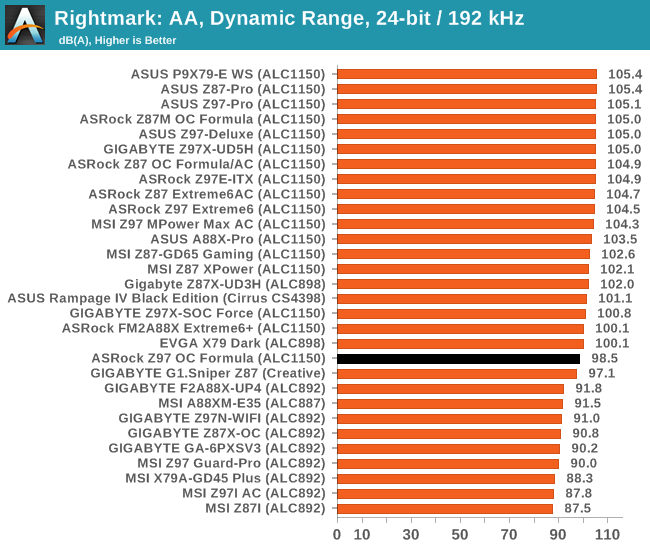
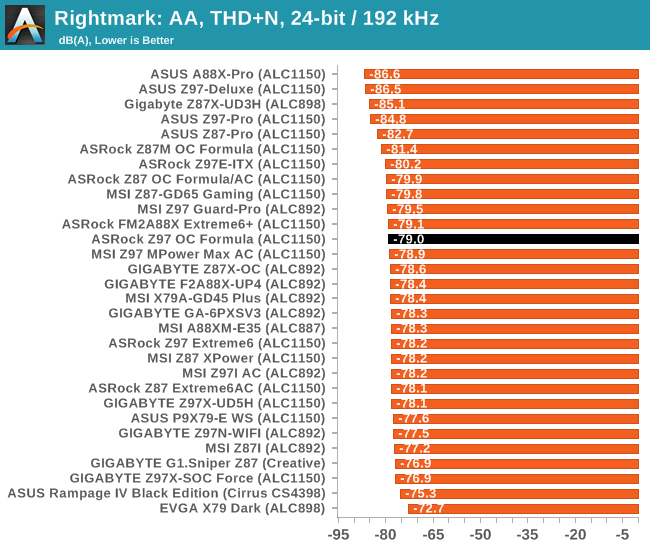
Audio performance is surprisingly low for an ALC1150 based motherboard. It would seem that around the 10 kHz and 30-50 kHz ranges this setup does not perform that well.
USB Backup
For this benchmark, we transfer a set size of files from the SSD to the USB drive using DiskBench, which monitors the time taken to transfer. The files transferred are a 1.52 GB set of 2867 files across 320 folders – 95% of these files are small typical website files, and the rest (90% of the size) are small 30 second HD videos. In an update to pre-Z87 testing, we also run MaxCPU to load up one of the threads during the test which improves general performance up to 15% by causing all the internal pathways to run at full speed.
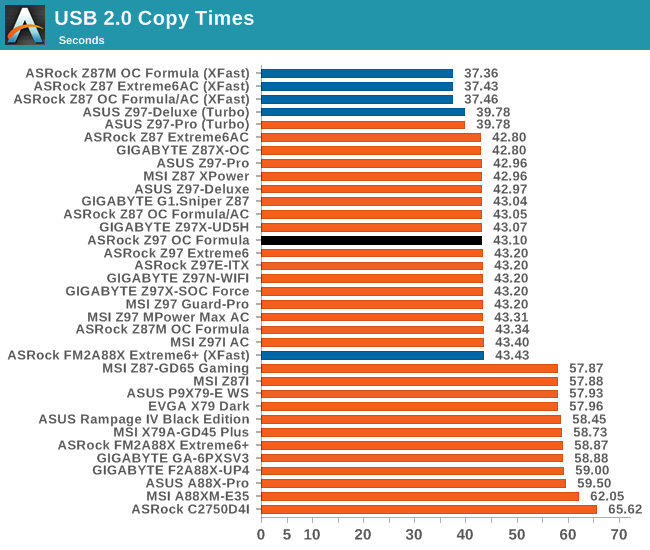
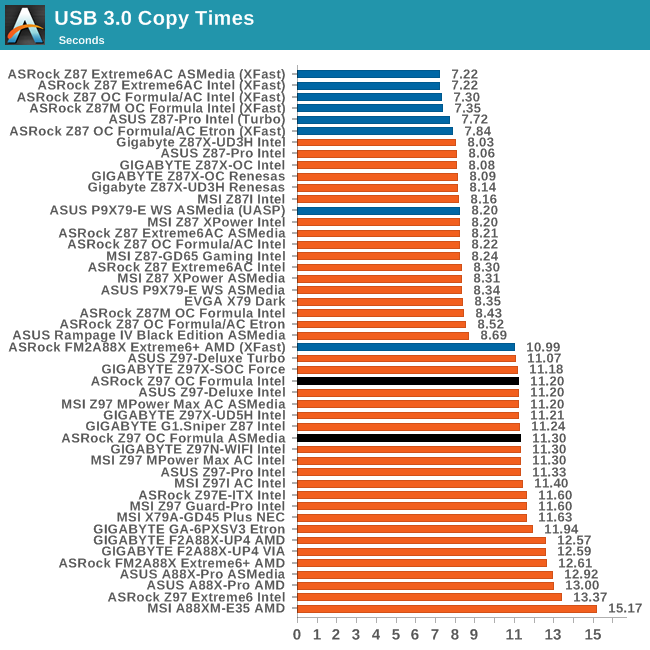
USB performance is in the top half of the pack, with the ASMedia USB hub doing reasonably well.
DPC Latency
Deferred Procedure Call latency is a way in which Windows handles interrupt servicing. In order to wait for a processor to acknowledge the request, the system will queue all interrupt requests by priority. Critical interrupts will be handled as soon as possible, whereas lesser priority requests such as audio will be further down the line. If the audio device requires data, it will have to wait until the request is processed before the buffer is filled.
If the device drivers of higher priority components in a system are poorly implemented, this can cause delays in request scheduling and process time. This can lead to an empty audio buffer and characteristic audible pauses, pops and clicks. The DPC latency checker measures how much time is taken processing DPCs from driver invocation. The lower the value will result in better audio transfer at smaller buffer sizes. Results are measured in microseconds.
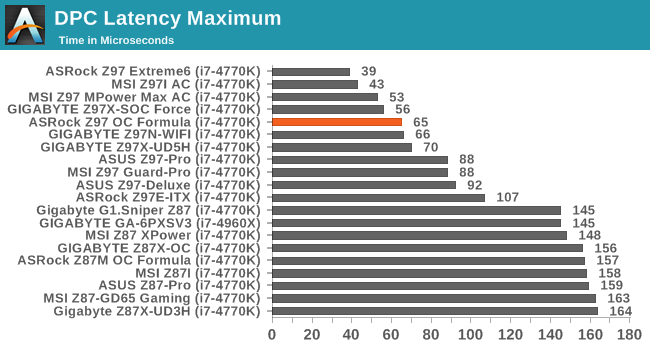
DPC Latency continues to be a positive point for Z97, with the OC Formula achieving 65 microseconds at peak.


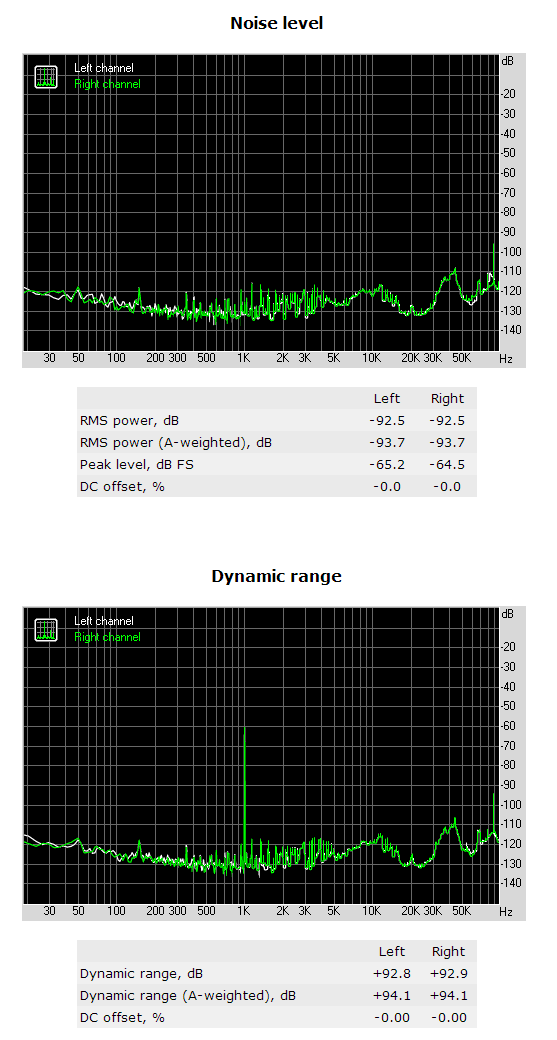








21 Comments
View All Comments
poohbear - Friday, October 3, 2014 - link
Oh and if ure looking for auto overclocking, this mobo is as good as it gets! Very simple & straight forward with very little hassle & ure at 4.6ghz.zent - Friday, October 3, 2014 - link
You don't have to install that molex, I'm running MGPU just fine without it.The_Assimilator - Friday, October 3, 2014 - link
If Asrock had gone with standard Intel GbE instead of the crappy "Killer" ethernet, and ignored Thunderbolt (TB on an overclocking board, seriously?), they would've easily been able to get this board under the $200 mark. Maybe that would've also allowed them to use 4-pin fan headers for the whole board. All in all, a missed opportunity.gammaray - Friday, October 3, 2014 - link
Always wondered why they put 4 slots for video cards, i mean, how many people put 4 VCs in their rigs??The_Assimilator - Saturday, October 4, 2014 - link
I'm guessing the same people who buy "overclocking" boards.gammaray - Saturday, October 4, 2014 - link
hmm, no, i always buy OC boards, but only use 1 video card.Shiitaki - Saturday, October 4, 2014 - link
The comments are more interesting than the motherboard review. iGP display port connector, really? LoL 4 vs 3 ping fan headers? Not enough USB ports? And there is a difficult to get to molex if you have a small case? Complaining about the TB header?This board is an oddity because if I was going to run a lot of hardware, why would I use a 1150 cpu? And for the AMD fan boys, Intel crushes AMD, not sure why AMD is included in any of the benchmarks, since this is theoretically aimed at the performance market. Seems a socket 2011 would be better. I think the reason this board will be bought is because it looks good in a windowed case. It's geek jewelry.
My only complaint is PS/2 ports, really? Seriously? PS/2 ports? At least the printer and serial ports have finally been deprecated.
zent - Saturday, October 4, 2014 - link
Do you own a mechanical keyboard? My QPAD (bought in 2014, not 1999) is native PS/2.Kanuj5678 - Sunday, October 5, 2014 - link
i have been using the Z77 extreme 6 mother board it is a good board but have minor issues with USB ports and sound output at timesredwolfe98 - Tuesday, October 7, 2014 - link
i love the yellow and black color scheme..